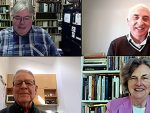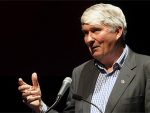We all like things neat, uncomplicated and in good order. But as we step over the threshold into the virtual world created by artificial intelligence, it seems to me that inclination may be more problematic than ever.
Over the past few weeks, I’ve seen a number of images circulating on social media. A baby dolphin, a 1901 photograph of a family with 18 children, two little boys of different races enjoying friendship: nothing controversial.
The response to these images is almost universally positive. That’s because the images are created to be universally appealing.
The problem is that these images aren’t real. They are created by AI.
Flawless vs. real
What’s the big deal? More and more people are becoming unable to tell the difference between what is real and what isn’t.
Even worse, we seem to be developing a preference for flawless and beautiful images over messy and imperfect reality.
I’m grateful that God does not.
At the end of June, the church commemorates her two most influential (and flawed) leaders: Sts. Peter and Paul.
The irony of a shared feast day shouldn’t be lost on us. Despite the similarity of how their lives ended, both Peter and Paul had their issues.
Simon walked on water, but then sank. He proclaimed that Jesus was the Son of God, then cautioned him against going to Jerusalem.
Swearing he would remain loyal even if no one else did, within hours, Peter denied Jesus not once, but three times.
He was anything but the “rock” Jesus had called him to be — not exactly a firm foundation on which to build the church.
In his zeal for Jewish law, Saul orchestrated the stoning of Stephen.
He was ambitious and intent on rooting out members of this dangerous new Messianic cult.
He was a man with a mission, en route to Damascus to arrest wayward Jews and bring them back to Jerusalem in chains.
That was interrupted when Jesus appeared to him.
Poor Ananias must have been terrified when God sent him to minister to Saul. It’s no wonder Paul was not readily trusted by those who were following the way.
These two men could not have been more different from each other.
Simon was not well educated, and Saul was a scholar who had studied under one of the most esteemed rabbis in Jerusalem.
Simon was brash and impetuous, often jumping into things mouth first.
Saul was calculating and deliberative, carefully planning his next move.
Simon lived in Galilee, a crossroad of cultural and religious diversity. Saul grew up in Tarsus, exposed to the full force of Greek learning and achievement and its effect on Jewish thought.
Simon and Saul also came to faith in Christ in entirely different ways.
Simon’s discipleship grew organically and over time. He became “Peter” slowly.
In contrast, Saul was struck blind by an unexpected mystical encounter (see image). When he regained his sight, he was “Paul,” suddenly part of a community he had considered heretical. Read more
- Jaymie Stuart Wolfe is an author, singer-songwriter, and lay evangelist. A 1983 convert to the Catholic faith, Jaymie is a wife and mother of eight.
News category: Analysis and Comment.




